We’ve been doing inbound marketing for a while, since 2012 to be exact. We’ve seen some pretty impressive results in that time from clients who adopted the inbound methodology into their marketing strategy. In a recent post, we walked you through creating an effective inbound marketing strategy from setting goals to measuring success. Now we’re going to look at what those efforts look like in real life.
10 Examples of Inbound Marketing Success
This post includes examples of small, medium, and large businesses who are doing inbound marketing well, from creative content offers to click-worthy email campaigns. Some are doing great inbound marketing on many fronts, some have shown exceptional talent in one particular area. By looking at these examples, analyzing their methods, and understanding the strategy behind them, you can begin to use some of these techniques to up your inbound marketing game.
Table of Contents
SEO and Web Design
Search engine optimization gets people to your site. Good website design gets them to convert. Here we look at an ecommerce company and a publication that take two different approaches to building a successful SEO strategy.
Chewy
When you search for “dog food,” “organic dog food,” and “cheapest place to buy dog food,” Chewy is the first site to appear in the organic results. Since Chewy launched in 2011, the online retailer has become the Amazon of pet supplies. The product pages even look like Amazon’s, with reviews, plenty of product pictures, and discounted pricing to entice buyers to snag the deal while they can.
Something else Chewy has in common with Amazon is the robust descriptions. The description for this Blue Buffalo product is 150 words long with a sidebar chock full of keywords and a video about the product. Below, there is Blue Buffalo-branded content with about 250 words of text, multiple images, and more keywords, like breed size, ingredients, and terms like “grain-free.” Below that is user-generated content like Q&As and comments. This product has more than 1,780 reviews alone. That’s so much dog food-related content! Multiply that times the hundreds of dog food products they offer and you can see why Chewy has locked in the top spots in search.

Now you’re probably thinking, of course they are topping search. That company’s huge! But the way Chewy sets up its product pages is a great example for smaller ecommerce sites.
- Don’t skimp on descriptions.
- Use plenty of photos and video.
- Encourage user engagement through Q&As.
- If you have happy customers, ask them to leave a review.
Inbound Marketing Takeaway: Google’s SEO crawlers not only see the keywords on these pages, but also see that the content offer shoppers value. In today’s marketplace, a few sentences and a single product photo no longer cut it for the shopper—nor for SEO.
Runner’s World
If you search “running tips,” “Runner’s World“ has the top organic spot and featured snippet. Search “improve running speed,” and it’s the number two spot. It’s also got the second organic spot for “best running shoes.” Search “running a marathon” and “Runner’s World” has spots two, three, and four. You get the idea.
Let’s take a look at the site and why it’s content is breaking through on so many different search terms. This publication posts a significant amount of its monthly magazine content online, as well as online-only content, user blogs, and forums. Articles are clickable and share-worthy, with titles like, “13 Hamstring Exercises to Help You Build Strength and Ward Off Injury” and “Cardiac Arrest Survivor Finishes 10K With Nurses Who Saved His Life at Last Year’s Race.”
Articles are targeted to the audience—runners—on multiple levels, from how-to’s to inspirational stories of overcoming hardship to gear reviews. Beginners to seasoned runners can find content that’s targeted to their skill level with ease, thanks to tags above the homepage story titles.
“Runner’s World” also does a great job of optimizing URLs, title tags, and meta descriptions. Take a look at these URLs that popped up when I typed in the keyword “running a marathon.”
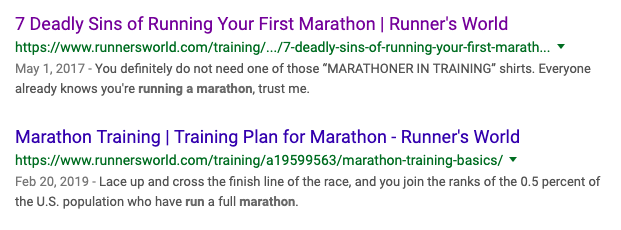
Here’s what we can learn from these results:
- Google has become smarter about delivering the results people want. These results show that Google infers you want how-to articles. Both title tags and meta descriptions make it clear the article includes advice on marathon training.
- These articles are not optimized for the same keyword or audience to prevent the links from competing with each other. The top link appears to be focused on “running your first marathon” by the looks of the title and URL, while the bottom link is aimed at people who are already runners and are looking to improve, as “26 tips for running your best 26.2” indicates.
- The results delivered here include a variation on the keyword I entered. “Run a full marathon” is not exactly “running a marathon” but Google is advanced enough to recognize it as a synonym. This just goes to show that torturing the content to make your exact keyword work isn’t as important as well-written titles and meta descriptions that people want to click on.
Inbound Marketing Takeaway: Content is the core product of “Runner’s World” so doing it well is clearly the company’s focus, yet any business can learn from its web presence. Most importantly:
- When creating content, target your audience in multiple ways with clickable, interesting news they can use.
- Don’t forget to optimize URLs, title tags, and meta descriptions with your keyword, or a synonym.
- Get people to click on your link with good writing.
Blogging and Content Offers
Regularly producing engaging content is always a challenge. It’s time consuming, takes a significant amount of creative energy, and the end product doesn’t always land the results you hoped for. It doesn’t have to be that hard, right? Here are two companies that are doing blogging and content offers a little differently.
Groove
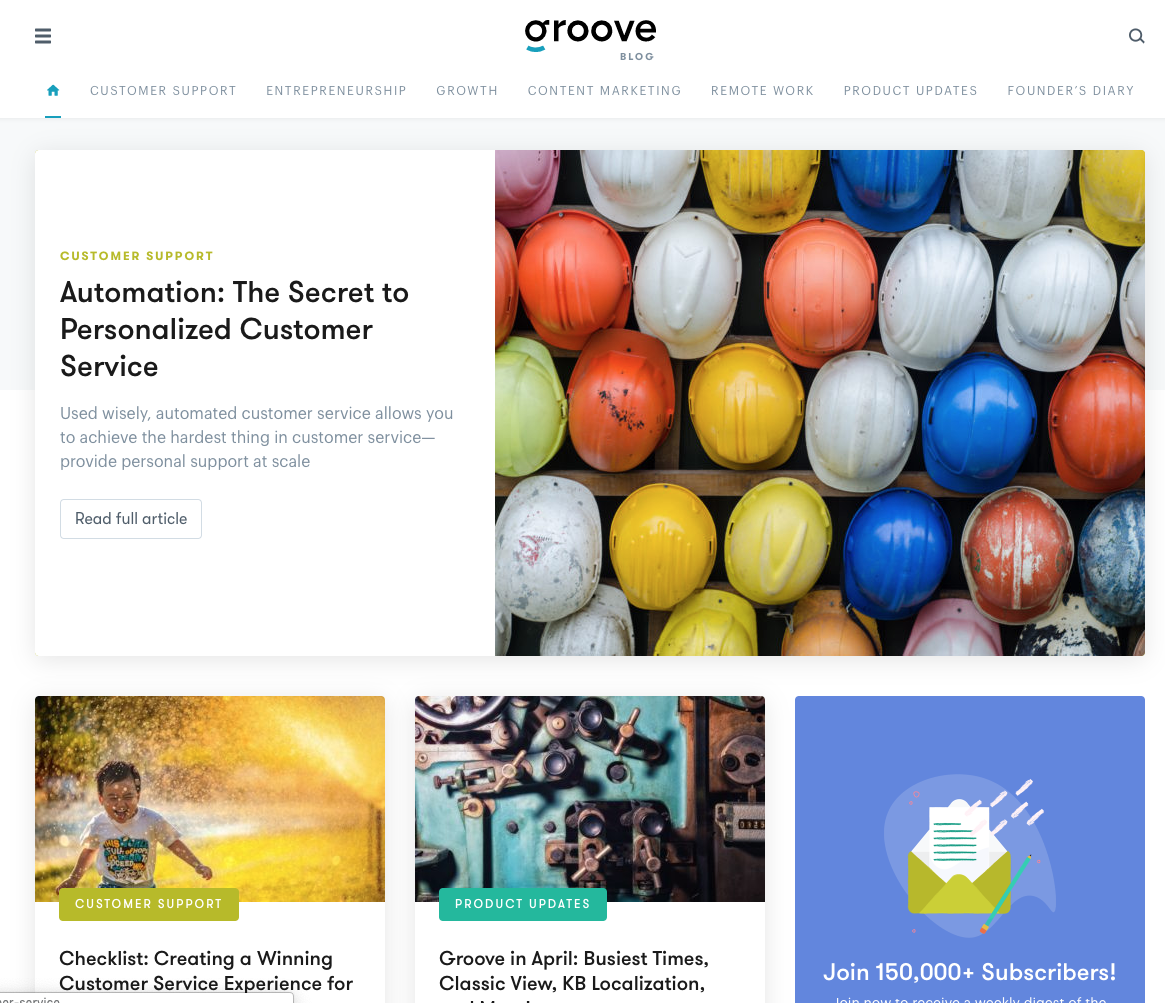
Groove is a productivity app marketed as an alternative to email, but it’s blog reads like a business-insider advice column. Readers can find news and updates about the Groove platform, as well as tips on entrepreneurship, content marketing, and growth targeted at start-ups and companies on the rise. With a no-BS style, Groove’s blog provides content related to its platform, but also dives into bigger-picture topics, like, what does customer service mean to your company, and the leadership skills you should be practicing. Here’s why this blog works:
- The posts are data driven, yet conversational, with examples, charts, and graphs to back up the arguments.
- There are lots of original images to break up text and illustrate concepts.
- The posts are easy to read and tell a good story – which Groove shows increases readership.
- By including bigger-picture topics, the blog casts a wider SEO net than productivity platform-related content alone might.
- Groove is not afraid to experiment with content offers within its blog and the CTAs that drive people to them.
Inbound Marketing Takeaway: The company blog isn’t just a place to park keywords. It’s a way for you to better tell your company’s story.
Unbounce
Unbounce has a thorough resource library with ebooks, courses, white papers, infographics, webinars, toolkits and much, much more. The content is relevant to Unbounce’s audience with basic how-tos like, “How to Get Started with A/B Testing,” as well as more in depth content, like “The Conversion Marketer’s Guide to Landing Page Copywriting.” What makes Unbounce’s content offers stand out? It’s the landing pages. They are exceptionally written and designed. Instead of offering an image of the content offer and a few vague platitudes about what you’ll find inside, the landing page has a thorough description of exactly what the offer will offer you. Check out this landing page for Unbounce’s Conversion Benchmark Report. It includes:
- A well-written and enticing introduction
- Statistics
- Charts
- Key takeaways
- Headshots of the authors, aka “the experts behind the report”
- A customer testimonial
The landing page promises the offer will give you “new and exclusive insights” into improving your conversion rate you can’t get anywhere else. If you clicked to the landing page half wondering if this content offer is even worth the read, chances are you’re far more likely to be all in with this thorough description of what’s inside.

Inbound Marketing Takeaway: How do you design and write a landing page with this much detail? Look to your content. Grab some stats, a chart, a few high-level takeaways, and then write a short but compelling description that quickly shows potential leads why this content offer is worth their time. Not every offer is going to reveal “new and exclusive insights,” but you should be able to hype some benefit, like saving time, improving understanding of complex topics, or making rote tasks less tedious.
How do you improve email when customers already get so much of it? The first step is getting people to open your company’s email. But once that small percentage opens the email, how do you get them to convert?
Social Print Studio
Social Print Studio is an online digital photo printing service that offers images in a wide range of formats, from wood prints to sticker sheets. While the company has offered discount codes and free shipping in various campaigns, the majority of the emails are about how customers can use the service. Take a look at these examples. You can see email campaigns for baby announcements, grads and dads, and new poster framing options.
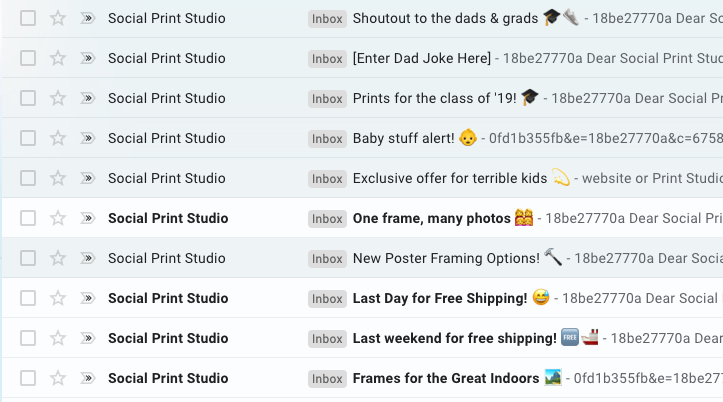
Once in the email, the images are creative and fun to look at, like this Father’s Day line quiz promo highlighting various products that would make a great gift for dad.
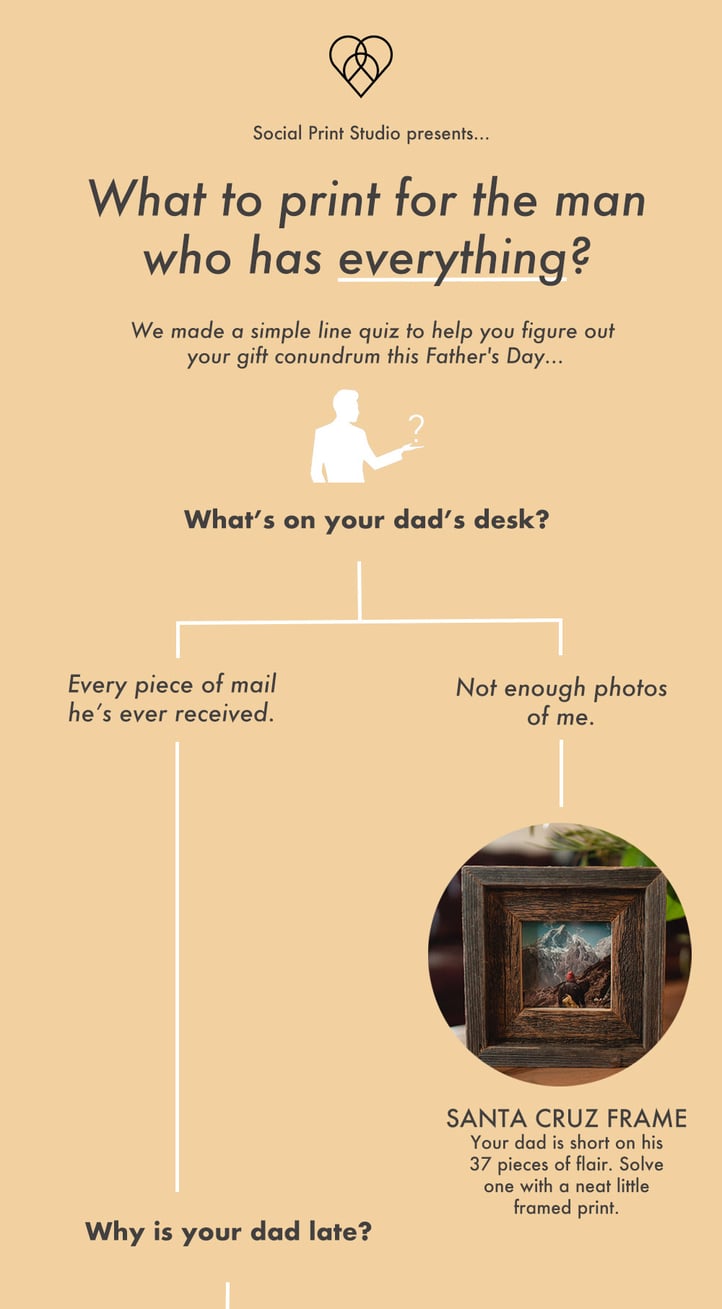
Social Print Studios emails emphasize “what’s new” even if the promo isn’t selling an entirely new product. For instance, the baby announcement email promotes new card templates, and another grads and dads email hypes new app features. Here are tips and tools Social Print Studio uses to convert email subscribers that you can do too:
- Using seasonal and holiday-themed campaigns
- Keeping subject lines short
- Using eye-catching images and animation at the top of the email
- Including links to products in the images
- Showing subscribers something new
Inbound Marketing Takeaway: Social Print Studio may use fancy images and emojis, but the email strategy is straight outta business school. Users download the app to print a few photos or some Christmas cards, and once that lead converts to a customer, Social Print Studio is all about the upsell and return customers. A great inbound strategy to accomplish that is through email.
Uber
Uber has had its ups and downs over the past year, but it’s still the number 1 ride sharing app in the world. Uber takes a different approach to email marketing with a strategy that uses geographically segmented lists to target customers and keep them riding. Email messages are personalized, with other personal touches that make the user feel appreciated as a customer.
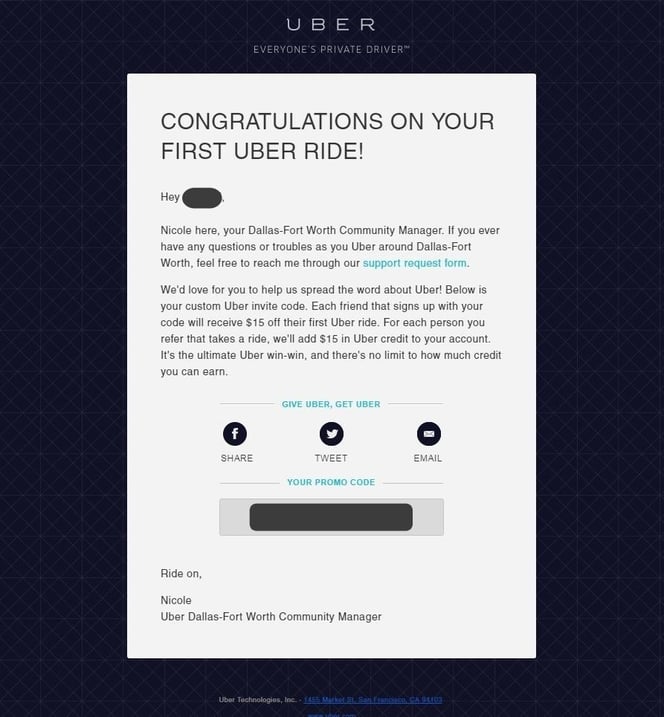
Here are some other strategies Uber uses to turn one-time customers into repeat customers:
- Personalized greeting
- Targeted emails segmented by state, enabling Uber to leverage regional traffic events
- Employee signed emails
- Embedded personal promo codes where users can earn credit for sharing with friends
- Follow-up emails after purchase in the form of ride summaries
Inbound Marketing Takeaway: You might notice this email design is far more sparse than Social Print Studio’s or those from other ecommerce companies. Uber is selling a service, not a product, and this simple, sleek messages that gets to the point works for them.
Social Media
Inbound marketing on social media is all about engagement. Companies are always looking for content that will grab attention and ultimately get users to click. Engagement can also shed light on what your customers are looking for in products and services. Here is how two companies are using social media in different ways to grow their business.
Birchbox
Birchbox is a beauty product company for women who like beauty products, but don’t have the time or money to try out lots of expensive moisturizers, concealers, or hair conditioners. This monthly subscription service sends sample-sized high-end beauty products to your door, with the option of buying larger sizes of any of the products you liked, with free shipping, at the Birchbox online shop.
When the company hit hard times in 2016, it cut way back on its marketing spend, eliminating TV ads and focusing instead on social media. Using Instagram, Facebook, Twitter, Pinterest, Youtube, and Snapchat, Birchbox focuses posts on colorful images of products, inspirational messages, and relatable people using its products. Here is a snapshot of its Instagram feed.

Because its customers are not seasoned beauty product experts, Birchbox created video content that offers advice and inspiration for trying new looks, edited differently for specific platforms. Here is what Birchbox learned about video for social media:
- Shorter videos with creative use of text perform well on Facebook because most videos on that platform are viewed without sound.
- Longer how-to videos, make-up tutorials, and unboxing videos do the best on YouTube.
- Live streaming chats and Q&A sessions are a good way to engage with customers on Snapchat and Facebook Live.
- Subjects that are not evergreen, such as limited-edition or holiday-themed products, are unboxed and shown on short-term platforms like Twitter’s Periscope and Snapchat.
Inbound Marketing Takeaway: Whether you are selling beauty products or outdoor gear, Birchbox’s social media strategy shows us it pays to offer useful information everyday women can use in a way that’s right-sized for each platform. Birchbox has recently gone from losing money to growing revenue and turning a profit.
HelloFresh
HelloFresh is the number one meal kit delivery service in America. How did it get there in such a highly competitive market? Part of the German company’s success is the result of social media listening.
HelloFresh is known for its variety in menu offerings and flexible plans, something the company was faster to develop than competitors like Blue Apron. In creating its marketing strategy, HelloFresh gathered consumer data from a variety of sources, but it was through social media listening that the company was better able to address customer complaints and learn how the product could be adjusted and improved to attract, and hopefully retain, customers. For example, HelloFresh was able to improve recipes, packaging, and delivery routes after a social listening analysis.
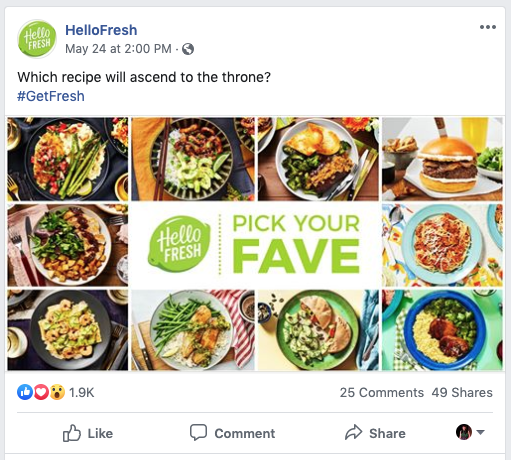
In addition to social listening, the company keeps social media content fresh and timely, mixing in tutorials and mouth-watering meal pics with timely, engaging content, like throwing a Game of Thrones reference in this Twitter contest asking people to vote for the best meal. Because customer retention rates in the meal kit service space are notoriously difficult to maintain, HelloFresh sees its job as earning the customers’ business every week. To do this, content must continually entice people to hang in there for that delicious craft burger or low-cal vegetarian dish the coming week.
Inbound Marketing Takeaway: HelloFresh is dominating the meal kit market and companies can emulate its social media strategy by:
- Investing in social listening and tracking audience feedback.
- Analyzing feedback for potential improvements to your products and services.
- Continuing to engage customers with great visual content that encourages feedback.
- Providing valuable content, like how-to videos.
Video
Video is arguably today’s most powerful tool for accomplishing inbound marketing goals. It has the ability to convey a message in a highly-engaging way, and if done right, can connect to the viewer on an emotional level unlike any other content format can.
thredUP
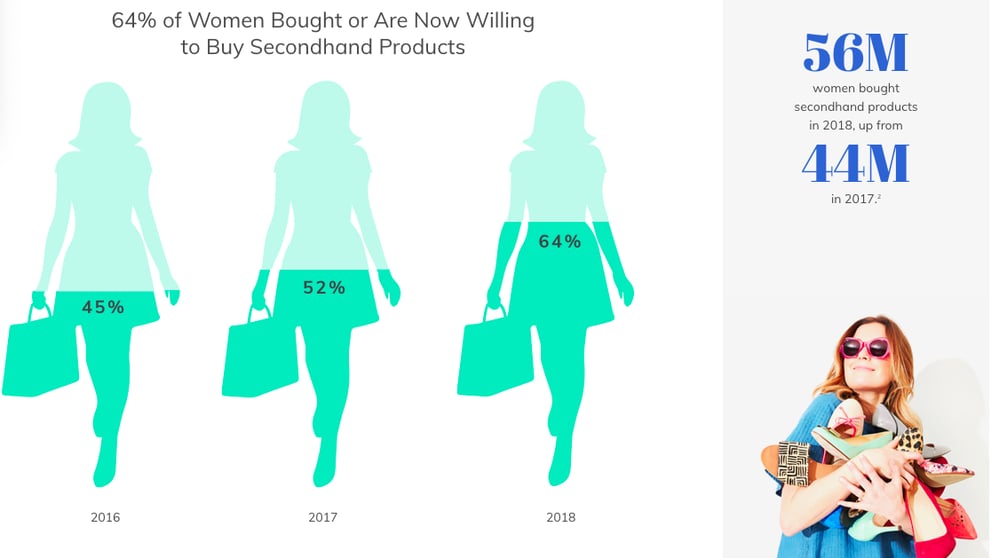
Before thredUp came on the scene, buying used clothes was largely for people who wanted to save money. But through its marketing efforts and its Annual Resale Report, thredUP has been influential in changing the consignment conversation from saving money to saving the planet.
The Resale Report is a piece of slickly produced non-gated content done in collaboration with GlobalData, a third-party research and analytics firm, with the goal of examining the $24 billion resale apparel market. The content serves as an important education piece for business and fashion publications, providing all the important details a reporter needs to write about what’s happening in the resale fashion business. It emphasizes that shopping consignment is an effective way to reduce waste, which younger, more environmentally conscious shoppers are sure to see as a true advantage, while also chipping away at the stigma of wearing second hand clothing in older shoppers.
But wait—this is supposed to be about video right? Well, we’re getting there. Part of thredUp’s marketing strategy was to change the way people look at consignment. Changing public perception can be one of the most difficult tasks in marketing, but is doable if your marketing efforts are:
- Data driven
- Visually appealing
- Tell a story
thredUP CEO believes storytelling is an important aspect of marketing, and that video is a worthy investment to accomplish that goal. “Go long in online video content. At thredUP we’ve seen the story-telling aspect of video helps engage customers better and turn them into stronger customers and brand advocates,” said James Reinhart, CEO of thredUP. “While the upfront costs may be higher, we’ve seen the ROI in the short and long-term.”
Taking a look at thredUp’s video content on YouTube, we see a mix of tutorials, unboxing videos, commercials, and thredUp-sponsored vlogs and videos. thredUp videos largely feature approachable women who are staffers and customers who represent a variety of ethnicities and body types. The videos show off fashion-forward, affordable clothes available on thredUp, pushing women to shop the site, while also reinforcing the message that shopping second hand comes with less guilt because you’re also reducing textile waste.
Inbound Marketing Takeaway: Changing the conversation through marketing takes time, but employing good storytelling via a compelling medium like video can be an effective way to accomplish it.
Moz
The SEO consulting and software company Moz faces a lot of inbound marketing pressure. You can’t really grow and maintain prominence as an SEO company unless you’re regularly landing in the top spots in search.
Moz has an estimated 30,000 customers, makes more than $40 million in subscriptions, and is considered one of the top resources for improving SEO. So how did it get there? According to Moz founder Rand Fishkin, the secret is great content.
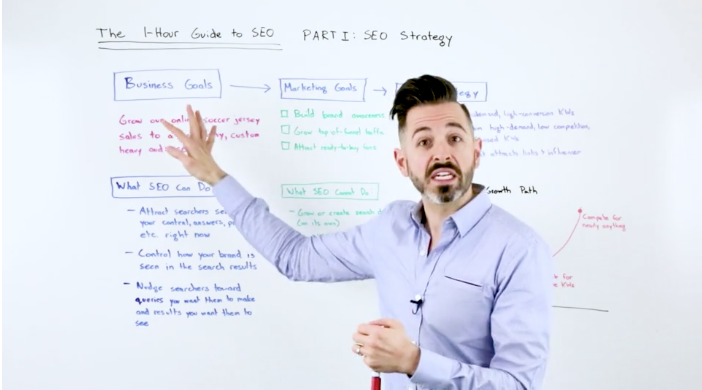
Part of that great content formula included the company’s now well-known “WhiteBoard Friday.” Launched in 2007, the weekly video series gives viewers SEO tips and strategies in roughly 10 minutes. Categories range from reporting and link building to advanced SEO tactics. It’s easily digestible and valuable content for businesses and bloggers alike. Here’s how Moz uses these videos to boost SEO and brand authority:
- Videos are posted with the video transcript, turning a short video into a resource users can return to again and again.
- Video transcripts are rich in keywords, easy to read, and double the value of the video content for SEO.
- Content ranges from beginner to advanced, attracting multiple buyer personas.
- The video page provides plenty of information about what’s in the video, so people can better judge if the video is what they’re looking for and as a result are likely to watch longer if they click.
- Instructors are casual and conversational, but also informed. By having someone from Moz speaking directly to users in a friendly and approachable way, it builds trust and reinforces the perception that Moz is a top authority on SEO.
Moz offers users tons of valuable content for free. When people use these free resources and see results, they are far more likely to spend money to access more, as we see with Moz’s subscription and certification success.
Inbound Marketing Takeaway: Your company likely does not have the time or resources to produce hundreds of instructional videos like Moz, but the concepts are still relevant. A hair salon can go a long way in building trust with prospective customers by producing a dozen demo videos on color correction, up-dos, and the right way to cut bangs (we’ve all made that mistake, right?). Need ideas on what your company videos should be about? Talk to customers about what they’d like to know.
That’s 10 But Before You Go…
You’ve heard it before. Getting inbound marketing right requires great content. But it’s also important to remember, as we see in the examples above, great content takes planning, alignment with the company’s goals, and the desire to put the work into a great product. You can get a leg up on your inbound efforts by downloading Raka’s marketing bundle below.






